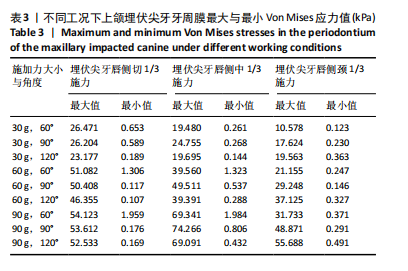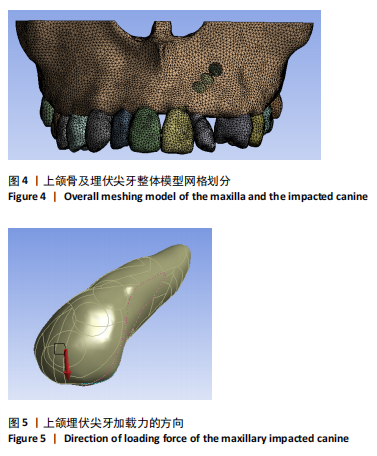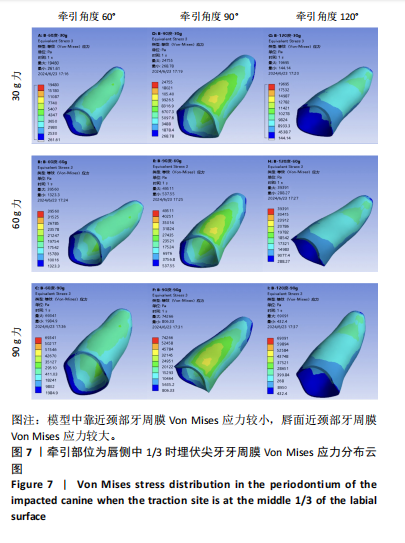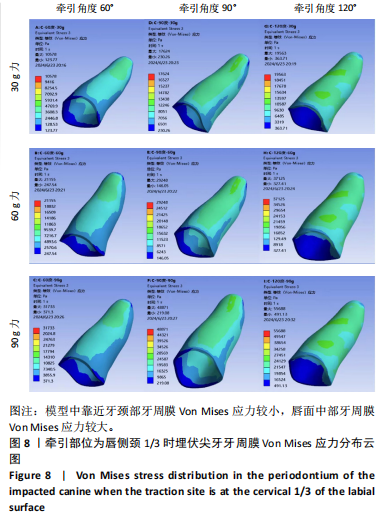[1] PERALTA-MAMANI M, LÓPEZ-LÓPEZ J, HONÓRIO HM. CBCT vs panoramic radiography in assessment of impacted upper canine and root resorption of the adjacent teeth: A systematic review and meta-analysis. J Clin Exp Dent. 2024;16(2):e198.
[2] GOH PKT, PULEMOTOV A, NGUYEN H, et al. Treatment duration by morphology and location of impacted maxillary canines: A cone-beam computed tomography investigation. Am J Orthod Dentofacial Orthop. 2024:S0889-5406(24)00148-3. doi: 10.1016/j.ajodo.2024.04.010.
[3] SIMIĆ S, NIKOLIĆ P, STANIŠIĆ ZINDOVIĆ J, et al. Root resorptions on adjacent teeth associated with impacted maxillary canines. Diagnostics. 2022;12(2):380.
[4] 钟燕雷,曾祥龙,贾绮林,等.上颌埋伏尖牙阻生的临床分析[J].中华口腔医学杂志,2006,41(8):483-485.
[5] ALQERBAN A. Impacted maxillary canine in unilateral cleft lip and palate: A literature review - ScienceDirect. Saudi Dent J. 2019;31(1):84-92.
[6] 刘安琪,钱玉芬.上颌尖牙阻生原因及其对周围结构的影响[J].上海口腔医学,2017,26(6):684-688.
[7] KUCUKKARACA E. Characteristics of Unilaterally Impacted Maxillary Canines and Effect on Environmental Tissues: A CBCT Study. Children (Basel). 2023;10(10):1694.
[8] FEKONJA A. Comparisons of Two Different Treatment Methods for Impacted Maxillary Canines: A Retrospective Study. J Clin Med. 2024; 13(8):2374.
[9] 张建航,张晓蓉.上颌尖牙埋伏阻生正畸治疗的研究进展[J].北京口腔医学,2017,25(1):52-54.
[10] VIKTORIJA G, DONATA J, KRISTINA K. Diagnostic methods and treatment strategies of impacted maxillary canines: A literature review. Stomatologija. 2019;21(1):3-12.
[11] LIU X, CHENG Y, QIN W, et al. Effects of upper-molar distalization using clear aligners in combination with Class II elastics: a three-dimensional finite element analysis. BMC Oral Health. 2022;22(1):546.
[12] NEVES AM, DO NASCIMENTO MCC, DE ALMEIDA CARDOSO M, et al. Finite element analysis of a newly designed miniplate for orthodontic anchorage in the maxillary anterior region. Am J Orthod Dentofacial Orthop. 2022;162(5):656-667.
[13] ELSHAZLY TM, BOURAUEL C, ALDESOKI M, et al. Computer-aided finite element model for biomechanical analysis of orthodontic aligners. Clin Oral Investig. 2023;27(1):115-124.
[14] ZHANG Y, HUI S, GUI L, et al. Effects of upper arch expansion using clear aligners on different stride and torque: a three-dimensional finite element analysis. BMC Oral Health. 2023;23(1):891.
[15] MAO B, TIAN Y, LI J, et al. Expansion rebound deformation of clear aligners and its biomechanical influence: a three-dimensional morphologic analysis and finite element analysis study. Angle Orthod. 2023;93(5):572-579.
[16] 李惠琴,王春娟,王禹,等.无托槽隐形矫治器治疗下颌不同形态扭转牙的三维有限元分析[J].中国组织工程研究,2023,27(7):1050-1054.
[17] OH S, CHOI YK, KIM YI, et al. The Center of Resistance of an Impacted Maxillary Canine: A Finite Element Analysis. Appl Sci. 2023;13(20): 11256.
[18] NG WL, CUNNINGHAM A, PANDIS N, et al. Impacted maxillary canine: Assessment of prevalence, severity and location of root resorption on maxillary incisors: A retrospective CBCT study. Int Orthod. 2024; 22(3):100890.
[19] FIRINCIOGLULARI M, KURT D, KORAL S, et al. Maxillary Canine Impaction: Assessing the Influence of Maxillary Anatomy Using Cone Beam Computed Tomography. Med Sci Monit. 2024;30:e944306.
[20] YANG JS, CHA JY, LEE JY, et al. Radiographical characteristics and traction duration of impacted maxillary canine requiring surgical exposure and orthodontic traction: a cross-sectional study. Sci Rep. 2022;12(1):19183.
[21] 金作林.埋伏阻生牙的正畸综合治疗[J].口腔疾病防治,2023,31(5): 305-311.
[22] CHAUHAN D, DATANA S, AGARWAL SS, et al. Development of difficulty index for management of impacted maxillary canine: a CBCT-based study. Med J Armed Forces India. 2022;78(1):61-67.
[23] DURGEKAR SG. Evaluation of skeletal and dentoalveolar dimensions in patients with maxillary unilateral impacted canine: A cone beam computed tomographic study. Clin Oral Investig. 2023;27(7):4073-4082.
[24] ZENO KG, MUSTAPHA S, AYOUB G, et al. Effect of force direction and tooth angulation during traction of palatally impacted canines: A finite element analysis. Am J Orthod Dentofacial Orthop. 2020;157(3):377-384.
[25] JIA L, WANG C, WANG C, et al. Efficacy of various multi-layers of orthodontic clear aligners: a simulated study. Comput Methods Biomech Biomed Engin. 2022;25(15):1710-1721.
[26] 吴越琳,刘加荣.三维有限元分析在口腔医学领域的研究进展[J].口腔医学,2021,41(7):659-663.
[27] ALHASYIMI AA, AYUB A, FARMASYANTI CA. Effectiveness of the Attachment Design and Thickness of Clear Aligners during Orthodontic Anterior Retraction: Finite Element Analysis. Eur J Dent. 2024;18(1):174-181.
[28] 唐倩,欧晓丽,方志欣,等.无托槽隐形矫治器扩展上颌牙弓时附件差异对后牙位移的三维有限元分析[J].中国美容医学,2024, 33(6):117-120.
[29] 李慧,张栋梁.两种隐形正畸序列磨牙远移的有限元比较[J].医用生物力学,2024,39(2):326-331.
[30] SEO JH, EGHAN-ACQUAH E, KIM MS, et al. Comparative analysis of stress in the periodontal ligament and center of rotation in the tooth after orthodontic treatment depending on clear aligner thickness—Finite element analysis study. Materials (Basel). 2021;14(2):324.
[31] HEMANTH M, DEOLI S, RAGHUVEER HP, et al. Stress induced in periodontal ligament under orthodontic loading (Part II): a comparison of linear versus non-linear FEM study. J Int Oral Health. 201;7(9): 114-118.
[32] 覃思文,韩雪,徐于婵,等.基于三维有限元分析对无托槽隐形矫治器远中移动上颌尖牙的应力变化趋势初探[J].中国实用口腔科杂志,2021,14(5):553-559.
[33] ZHAO J, SU M, ZHAO Q, et al. 3D Finite Element Study of the Physiological Anchorage Control Concept on Anchorage Molars in Lingual Orthodontics. J Healthc Eng. 2022;2022:1421586.
[34] KıRMALı Ö, TÜRKER N, AKAR T, et al. Finite element analysis of stress distribution in autotransplanted molars. J Dent. 2022;119:104082.
[35] 孙志涛,孙阳,宋宇.内收力对不同牙槽骨高度后牙影响的三维有限元分析[J].现代口腔医学杂志,2024,38(2):118-122.
[36] 林青,邹玉春,许家辉,等.无托槽隐形矫治器用于上颌磨牙组牙扩弓的三维有限元分析[J].实用口腔医学杂志,2022,38(3):353-358.
[37] 黄智蕴,李宜宁,李若涵,等.两种加力方式下尖牙远中移动的有限元分析[J].临床口腔医学杂志,2022,38(4):215-218.
[38] LEE BW. Relationship between tooth-movement rate and estimated pressure applied. J Dent Res. 1965;44(5):1053.
[39] 汤荟文,回记芳,郑文涛,等.不同角度上颌埋伏中切牙牙合向牵引牙周应力分布的分析[J].现代口腔医学杂志,2016,30(1):16-19.
[40] 靳淑梅,王媛,任旭升,等.上颌埋伏尖牙及其支持组织三维有限元建模方法的研究[J].上海口腔医学,2010,19(1):95-99.
[41] MOUSA MR, HAJEER MY, BURHAN AS, et al. The effectiveness of minimally-invasive corticotomy-assisted orthodontic treatment of palatally impacted canines compared to the traditional traction method in terms of treatment duration, velocity of traction movement and the associated dentoalveolar changes: A randomized controlled trial. F1000Res. 2023;12:699.
[42] ALLAREDDY V, CAPLIN J, MARKIEWICZ MR, et al. Orthodontic and surgical considerations for treating impacted teeth. Oral Maxillofac Surg Clin North Am. 2020;32(1):15-26.
[43] 张建航,张晓蓉.上颌尖牙埋伏阻生正畸治疗的研究进展[J].北京口腔医学,2017,25(1):52-54.
[44] CICEK O, GUREL T, DEMIR CICEK B. Investigation of the Relationship of Impacted Maxillary Canines with Orthodontic Malocclusion: A Retrospective Study. Children (Basel). 2023;10(6):950. |





